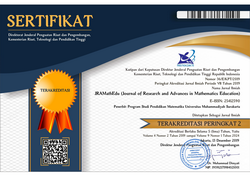Students’ visual thinking ability in solving the integral problem
Ummu Sholihah(1*), Maryono Maryono(2)(1) Tadris Matematika, Institut Agama Islam Negeri Tulungagung,
(2) Tadris Matematika, Institut Agama Islam Negeri Tulungagung,
(*) Corresponding Author
Abstract
Visual thinking plays an essential role in solving problems and in learning mathematics. Many students do not understand how to graphically or geometrically represent problems and solve algebra problems. Visual thinking is the ability, process, and results of creating, interpreting, using, and imagining images and diagrams on paper or with technological tools, describing and communicating information and ideas, developing ideas, and understanding improvement. This research describes students’ visual thinking ability to solve integral problems. The approach used in this study was descriptive qualitative. The subjects in this study were three students from the Department of Mathematics Education at the State Islamic Institute of Tulungagung. The data were collected by using tests and interviews. The steps to analyze the data were categorization, reduction, exposure, interpretation, and conclusion. Based on the analysis of students’ visual thinking skills in solving integral problems, there were three levels of visual thinking: semi-local visual, local visual, and global visual. At the semi-local visual level, students could only understand algebraically, and they have not shown it graphically at all. Meanwhile, at the local visual level, they have already understood geometry as an alternative language and been able graphically represented problems or concepts, even though it was not perfectly done yet. While on a global visual level, they could perfectly visualize visual thinking indicators, understand algebra and geometry as alternative languages for problem-solving, extract specific information from diagrams, graph problems, and use them to solve problems perfectly.
Keywords
Full Text:
PDFReferences
Arcavi Abraham. (2003). The Role of Visual Representations in the Learning of Mathematics. Educational Studies in Mathematics. Educational Studies in Mathematics, 52, 215-242. https://doi.org/10.1023/A:1024312321077
Dubinsky, E. (2013). Using a Theory of Learning in College Mathematics Courses. MSOR Connections, 1(2), 10–15. https://doi.org/10.11120/msor.2001.01020010
Goldin, G., & Shteingold, N. (2001). Systems of representations and the development of mathematical concepts. In A. A. Cuoco, & F. R. Curcio (Eds.), The roles of representation in school mathematics: 2001 yearbook of the national council of teachers of mathematics (pp. 1-23). Reston, VA: NCTM.
Guler, G., & Ciltas, A. (2011). The visual representation usage level of mathematics teachers and students in solving verbal problems. International Journal of Humanities and Social Science, 1(11), 145-154. Retrieved from http://www.ijhssnet.com/journals/Vol_1_No_11_Special_Issue_August_2011/17.pdf
Güven, B., & Kosa, T. (2008). The Effect Of Dynamic Geometry Software On Student Mathematics Teachers’ Spatial Visualization Skills The Turkish Online Journal of Educational Technology, 7(4), 100–107. Retrieved from https://files.eric.ed.gov/fulltext/EJ1102930.pdf
Hartono. (2010). Mental Imagery: tinjauan dari segi filsafat, Ilmu-ilmu Kognitif dan Neurologis. Surabaya: UNESA University Press.
Huang, C. (2013). Engineering students’ visual thinking of the concept of definite integral. Global Journal of Engineering Education, 15(2), 111–117. Retrieved from http://www.wiete.com.au/journals/GJEE/Publish/vol15no2/06-Huang-C-H.pdf
Kang, R & Liu, D. (2018). The Importance of Multiple Representations of Mathematical Problems: Evidence from Chinese Preservice Elementary Teachers’ Analysis of a Learning Goal. International Journal of Science and Mathematics Education, 16, 125-143. Retrieved from https://eric.ed.gov/?id=EJ1165850
Kurniawati, N. K. (2013). Komunikasi Antarpribadi. Yogyakarta: Graha Ilmu.
Mahir, N. (2009). Conceptual and procedural performance of undergraduate students in integration. International Journal of Mathematical Education in Science and Technology, 40(2), 201 -211. https://doi.org/10.1080/00207390802213591
Nufus, H., Duskri, M., & Bahrun, B. (2018). Mathematical Creative Thinking and Student Self-Confidence in the Challenge-Based Learning Approach. JRAMathEdu (Journal of Research and Advances in Mathematics Education), 3(2), 57-68. https://doi.org/10.23917/jramathedu.v3i2.6367
Presmeg, N. (2006). Research on Visualization in Learning and Teaching Mathematics. In A. Gutiérrez, & P. Boero (Eds.), Handbook of Research on the Psychology of Mathematics Education: Past, Present and Future (pp. 205-236). Rotterdam: Sense. Retrieved form https://www.scirp.org/(S(vtj3fa45qm1ean45vvffcz55))/reference/ReferencesPapers.aspx?ReferenceID=1503352
Roam. (2011). The magic of Picture. Translated from The Back Of Napkin. Jakarta Selatan: ufuk Press, PT. Ufuk Publishing House.
Schunk, D. H. (2012). Learning Theories an Educational Perspektive. United States of America: Pearson Education Inc.
Serhan, D. (2016). Students’ Understanding of the Definite Integral Concept. International Journal of Research in Education and Science, 1(1), 84-88. Retrieved from https://files.eric.ed.gov/fulltext/EJ1105099.pdf
Sholihah, U., & Asyhar, B. (2018). The Student’s Visual Thinking Profile in Solving Mathematics Problems, (June). Proceedings of the University of Muhammadiyah Malang's 1st International Conference of Mathematics Education (INCOMED 2017) https://doi.org/10.2991/incomed-17.2018.16
Skemp, R. R. (2013). Relational Understanding and Instrumental Understanding. Retrieved from http://www.davidtall.com/skemp/pdfs/instrumental-relational.pdf
Sternberg R J. (2008). Psikologi Kognitif. Yogyakarta: Pustaka Pelajar.
Stokes, S. (2001). Visual Literacy in Teaching and Learning : A Literature Perspective. Electronic Journal for the Integration of Technology in Education, 1(1), 10–19. Retrieved from https://wcpss.pbworks.com/f/Visual+Literacy.pdf
Stylianou A, D. (2004). The role of visual representations in advanced mathematical problem solving: An examination of expert-novice similarities and differences. Mathematical Thinking and Learning, 6(4), 353-387. https://doi.org/10.1207/s15327833mtl0604_1
Suh, J. M., Chris. J. & Mills, M. (2008). Promoting Decimal Number Sense and Representational Fluency. Mathematics Teaching in the Middle School, 14(1), 44-50. Retrieved from https://eric.ed.gov/?id=EJ805046
Suharnan. (2005). Psikologi Kognitif. Surabaya: Srikandi.
Tasman, F., Hertog, J. D, Zulkardi, Z., & Hartono, Y. (2016). Helping Students Acquainted with Multiplication in Rectangular Model. Journal on Mathematics Education, 2(2), 185–198. https://doi.org/10.22342/jme.2.2.747.185-198
Umami, I. (2018). Moderating Influence of Curriculum, Pedagogy, and Assessment Practices on Learning Outcomes in Indonesian Secondary Education. Journal of Social Studies Education Research, 9(1), 60–75. Retrieved from https://jsser.org/index.php/jsser/article/view/243
Van de Walle, J, A. (2008). Elementary and Middle School Mathematies. PT Gelora Aksara Pratama: Erlangga.
Article Metrics
Abstract view(s): 965 time(s)PDF: 701 time(s)
Refbacks
- There are currently no refbacks.








